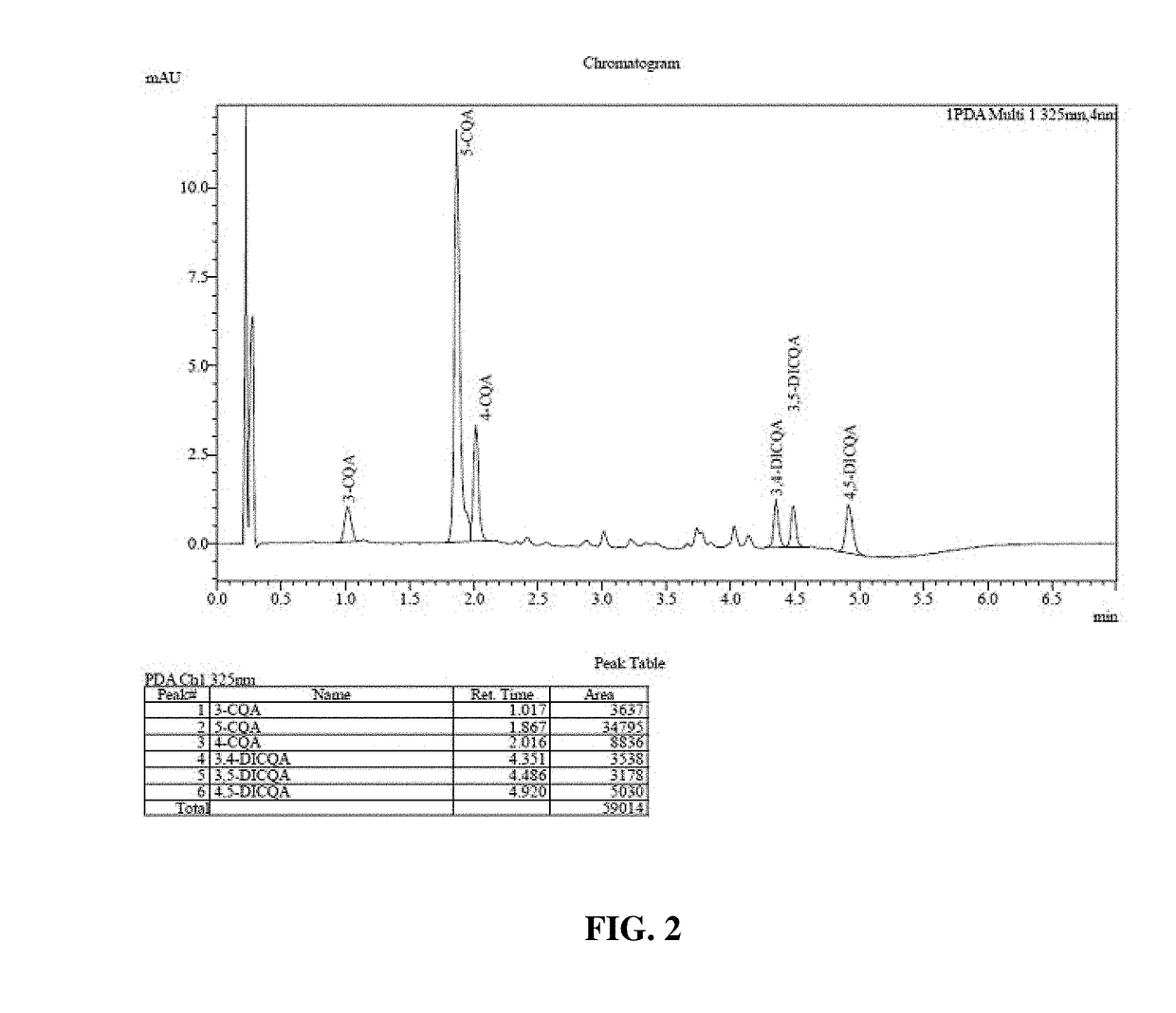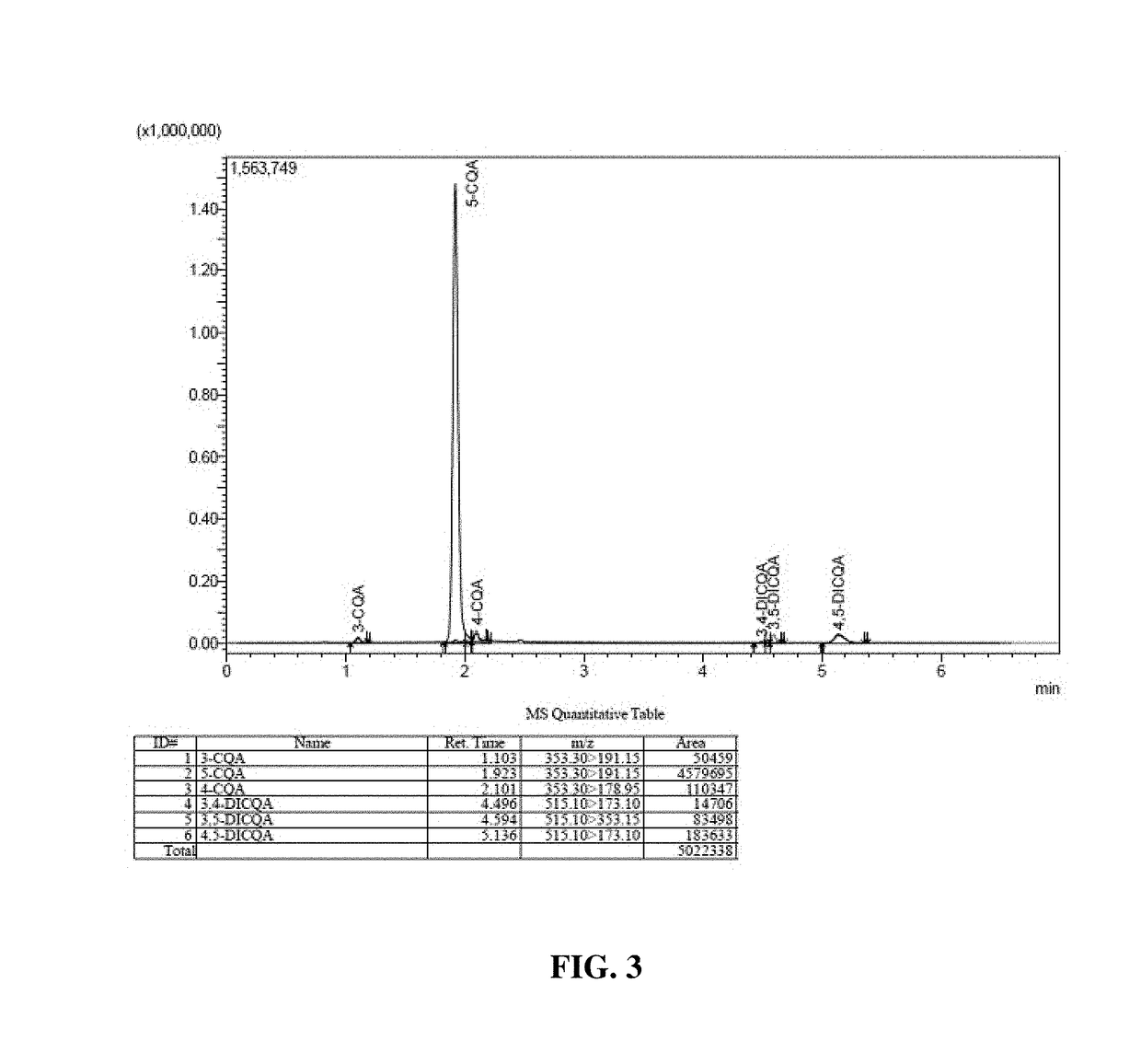Chlorogenic acid composition and method for its use in the treatment of alzheimer's disease
a technology of chlorogenic acid and alzheimer's disease, applied in the field of chlorogenic acid composition and botanical formulations, can solve the problems of affecting the effect of microtubule stabilization, affecting memory and cognitive ability, and affecting the normal aging biomarker, so as to improve the effect of stabilizing microtubules and reduce the effect of aging
- Summary
- Abstract
- Description
- Claims
- Application Information
AI Technical Summary
Benefits of technology
Problems solved by technology
Method used
Image
Examples
example 1
[0063]This example describes the preparation of one embodiment of the composition. The processes described in this example can be scaled up to produce larger quantities of the composition. The details provided for preparation of the following composition reflect the presently preferred method for extract preparations and should not be considered as limiting. The quantities and times described below can be varied substantially to provide suitable formulations derived from sunflower seed in accordance with the invention.
Preparation of Composition
[0064]100 kg of sunflower seed powder (20-40 mesh) was taken into a clean vertical 1.0 kL extractor. The bottom of the extractor comprised a perforated plate on which filtration cloth was fixed. The bottom of the extractor was connected to a transfer pump, input and outputs of the transfer pump connected to a T bend. One end was connected to the extractor top for circulation of the extraction mass during the extraction period and other end of ...
example 2
[0074]This example describes the phytochemical analysis of the composition from Example 1.
Estimation of Total Polyphenolic Content in the Composition by Folin-Ciocalteu's Method
Preparation of Standard Curve:
[0075]100 mg of standard chlorogenic acid (98% pure) was dissolved in 100 mL of 50% methanol solution (1 mg / mL) and then further diluted to 30, 60, 90, 120, 150 and 180 μg / mL. 1 mL aliquot of each dilution was taken in a test tube and diluted with 10 mL of distilled water. Then 1.5 mL Folin Ciocalteu's reagent was added and allowed to incubate at room temperature for 5 minutes. Four mL of 20% (w / w) Na2CO3 was added in each test tube, adjusted with distilled water up to the mark of 25 mL, agitated and left to stand for 30 min at room temperature. Absorbance of the standard was measured at 755 nm using UV / VIS spectrophotometer (Schimadzu, Japan) against blank (distilled water).
[0076]15-20 mg of the composition was taken into 100 mL of volumetric flask, then added ...
example 3
[0110]This example relates the use of the inventive composition for antioxidant and acetylcholinesterase activities in vitro.
[0111]The sample was prepared in 10% dimethyl sulphoxide (1 mg / mL) and further diluted to 10, 20, 40, 60, 80 and 100 μg / mL for the in vitro studies.
In Vitro Antioxidant Studies
Determination of 2,2-Diphenyl-1-Picrylhydrazyl (DPPH) Radical Scavenging Assay
[0112]The free radical scavenging capacity of the inventive composition was determined using DPPH scavenging assay (Braca et al. 2001). DPPH solution was prepared in 95% methanol. Freshly prepared DPPH solution was taken in test tubes and different concentration of test samples were added and incubated for 20 min The absorbance was read at 517 nm using a spectrophotometer. Blank was prepared containing the same volume of reaction mixture without any test sample. The percentage of scavenging was calculated using following formula:
% Scavenging=Ac−As / Ac×100
[0113]Where AC was the absorbance of the control (blank) a...
PUM
| Property | Measurement | Unit |
|---|---|---|
| Fraction | aaaaa | aaaaa |
| Fraction | aaaaa | aaaaa |
| Fraction | aaaaa | aaaaa |
Abstract
Description
Claims
Application Information
 Login to View More
Login to View More - R&D
- Intellectual Property
- Life Sciences
- Materials
- Tech Scout
- Unparalleled Data Quality
- Higher Quality Content
- 60% Fewer Hallucinations
Browse by: Latest US Patents, China's latest patents, Technical Efficacy Thesaurus, Application Domain, Technology Topic, Popular Technical Reports.
© 2025 PatSnap. All rights reserved.Legal|Privacy policy|Modern Slavery Act Transparency Statement|Sitemap|About US| Contact US: help@patsnap.com



